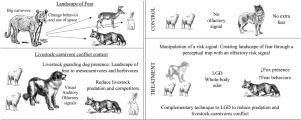嗅觉驱避剂是浸泡在畜牧系统中的中食肉动物的感知陷阱
IF 3.5
2区 环境科学与生态学
Q1 BIODIVERSITY CONSERVATION
引用次数: 0
摘要
猎物和中食肉动物通过大型食肉动物发出的风险信号来感知捕食风险。可以在不使中食肉动物面临真实风险的情况下操纵这些信号,通过感知陷阱制造恐惧景观,从而改变行为。尿液和粪便等嗅觉信号已被用于阻止食肉动物捕食家畜,但更具生物意义的提示可能更有效。家畜护卫犬(LGD)能阻止食肉动物并减少捕食,因此在家畜饲养系统中使用它们的全身气味作为风险信号可能有助于减少家畜与食肉动物之间的冲突。我们测试了 LGD 全身气味对巴塔哥尼亚狐狸(Lycalopex culpaeus 和 Lycalopex griseus)的影响,这些狐狸生活在三种不同的生境中(森林、灌丛和牧场),并分析了它们的行为变化。与没有气味的地方相比,LGD 全身气味的存在减少了狐狸在灌木丛栖息地的出现,并可能增加恐惧行为和减少食物消耗。这种技术可以作为 LGD 的补充,扩大其效果,但必须考虑到栖息地的特点才能使其有效。LGD全身气味是一种更真实的风险信号,它代表了LGD的存在,而不会让中型食肉动物遭遇真实的LGD,也就是一种感知陷阱,它可以帮助减少牲畜损失和食肉动物来自畜牧业主的威胁,从而促进畜牧业生产和本地食肉动物之间的共存。本文章由计算机程序翻译,如有差异,请以英文原文为准。

Olfactory repellents as perceptual traps for mesocarnivores immersed in livestock systems
Predation risk is perceived by prey and mesocarnivores through risk signals given by large carnivores. These signals can be manipulated without exposing mesocarnivores to real risk, creating landscapes of fear through perceptual traps, altering behavior. Olfactory signals like urine and feces have been used to deter carnivores that predate on livestock, but a more biologically meaningful cue could be more effective. Livestock guardian dogs (LGD) deter carnivores and reduce predation, so using their whole-body odor as a risk signal in a livestock system could contribute to reduce livestock-carnivore conflict. We tested LGD whole-body odor effect on Patagonian foxes (Lycalopex culpaeus and Lycalopex griseus) present in sheep production in three different habitats—forest, scrubland and pastureland—and analyzed behavioral changes. The presence of LGD whole-body odor reduce the presence of foxes in scrubland habitats and could increase fear behavior and reduced food consumption compared to non-scented places. This technique could act as a complement to LGD, amplifying its effect, but the habitat characteristics must be considered to make it effective. LGD whole-body odor, a more realistic risk signal, representing the presence of LGD without exposing mesocarnivores to a real encounter, i.e. a perceptual trap, could contribute to reduce livestock losses and carnivore threats from livestock owners, aiming to facilitate coexistence between livestock production and native carnivores.
求助全文
通过发布文献求助,成功后即可免费获取论文全文。
去求助
来源期刊

Perspectives in Ecology and Conservation
Environmental Science-Nature and Landscape Conservation
CiteScore
7.80
自引率
4.30%
发文量
46
审稿时长
59 days
期刊介绍:
Perspectives in Ecology and Conservation (PECON) is a scientific journal devoted to improving theoretical and conceptual aspects of conservation science. It has the main purpose of communicating new research and advances to different actors of society, including researchers, conservationists, practitioners, and policymakers. Perspectives in Ecology and Conservation publishes original papers on biodiversity conservation and restoration, on the main drivers affecting native ecosystems, and on nature’s benefits to people and human wellbeing. This scope includes studies on biodiversity patterns, the effects of habitat loss, fragmentation, biological invasion and climate change on biodiversity, conservation genetics, spatial conservation planning, ecosystem management, ecosystem services, sustainability and resilience of socio-ecological systems, conservation policy, among others.
 求助内容:
求助内容: 应助结果提醒方式:
应助结果提醒方式:


